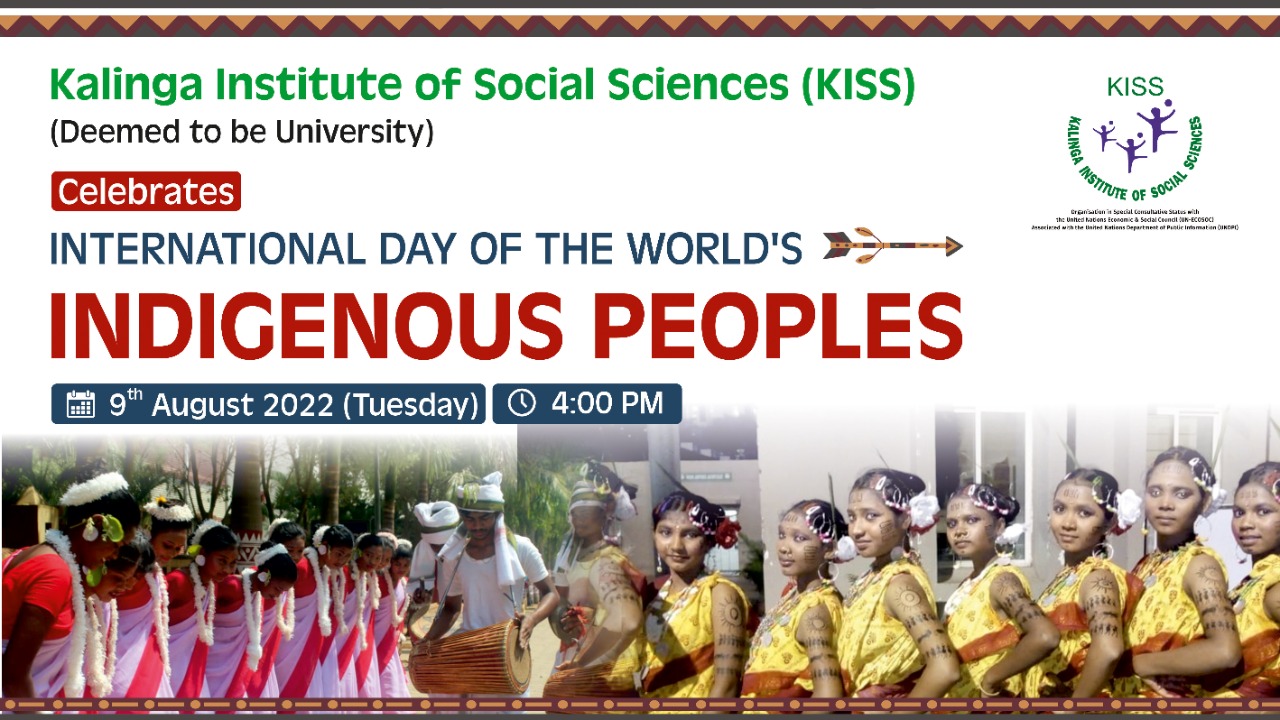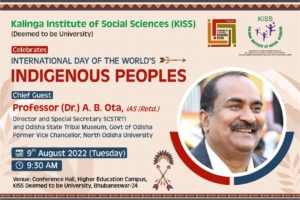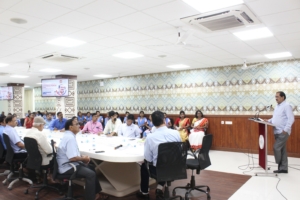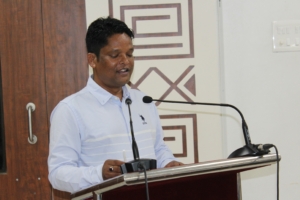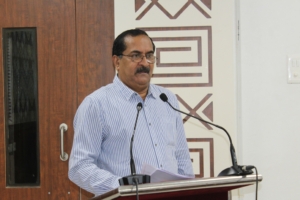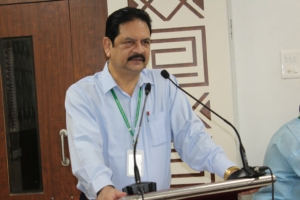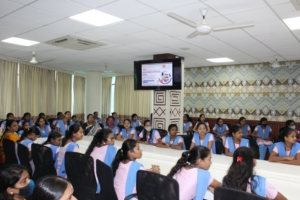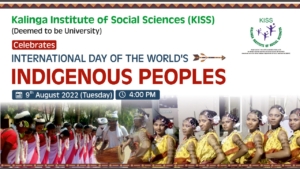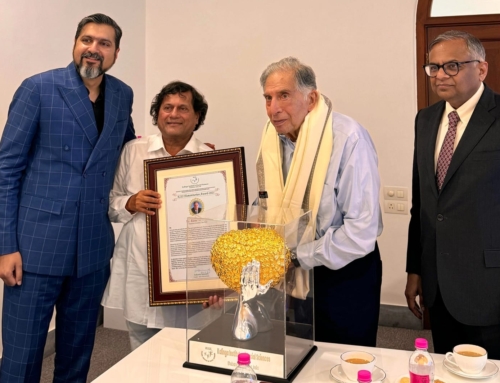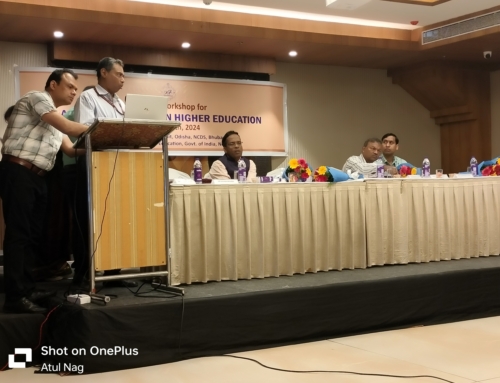KISS-DU celebrated the International Day of the World’s Indigenous People on 9th August 2022 by organizing a series of activities beginning with a special lecture by Professor A.B Ota, Director of the SCSTRTI, Govt. of Odisha, Bhubaneswar.
Professor Deepak Kumar Behera, Hon’ble Vice-Chancellor, KISS-DU delivered the welcome address and said that Professor A.B. Ota has encyclopaedic knowledge and research about the indigenous communities that are matched by his several positive interventions at the level of practice throughout his distinguished career as a senior civil servant.
Dr. K. C. Mahali, IPS (Retd.), Director General, KISS-DU spoke about the significance of celebrating the day during his address, and formally introduced the speaker on the occasion.
Dr. Prashanta Kumar Routray, Registrar, KISS-DU, emphasized on the kinds of innovative activities undertaken by KISS-DU with regard to protection, preservation, and promotion of tribal cultural heritage and diversity of the indigenous communities, substantiating that innovation at KISS-DU consists in taking up projects focused on community development. He took up on particular reference to the establishment of the Tribal Advisory Council at KISS-DU and the introduction of the concept of Professors of Practice. With this, Dr. Routray invited the distinguished speaker to deliver his address.
Professor Ota began with the history of the various international initiatives which eventually led to the institutionalization of the international day of the worlds’ indigenous peoples. The day was first celebrated in 1995 even though the date referred to the first meeting of the Special UN Group constituted to look into these questions in 1982. More importantly, Professor Ota made a careful distinction between the terms indigenous and tribal, referring to the relevant ILO conventions. Speaking at length on what he called the ‘cost of development’, he observed that the process of development would eventually result in the extinction of some aspects of indigenous cultures. In that context, he emphasized the need to document and map these cultures, particularly in the form of cultural artifacts, for future needs and as an inheritance for posterity. In this context, he presented a list of interventions already carried out in this direction in Odisha, including initiatives for GI tag for seventy-plus products, projects for the preservation of several tribal languages through the introduction of trilingual dictionaries, along with several museums and initiatives around then preservation of sacred groves. He spoke also about the recent recognition of Ol Chiki as one of the permissible scripts for the UPSC exam, and similar initiatives underway for the Ho language to be recognized in the eighth schedule. He concluded with a request for every KISS-DU student to collect and donate at least 10 household articles for a museum so that they are organized in a major museum at KISS, for posterity to learn about them and make use of the knowledge and wisdom embodied in their conception and usage.
The deliberation by the esteemed guests was followed by a Cultural Meet organized by the Cultural Wing of KISS-DU. The students of different tribes performed tribal dance, show casing rich tribal heritage, culture, diversity and ethos.
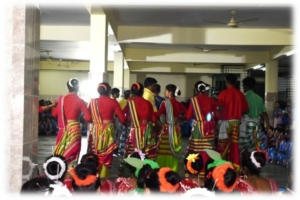 Among the Odishan tribes, the Santals are an advanced community. They are mainly found in the districts of Mayurbhanj, Keonjhar, and Balasore in the State. Besides, they also inhabit the neighboring states like Jharkhand, West Bengal, Bihar, and Assam. The word ‘Santal’ is derived from two words; Santa means calm and peaceful and ala means man. They speak the Santali language which belongs to the Munda group of Austro-Asiatic sub-family of languages. The Santali has its script called ‘Ol Chiki’ invented by Pandit Raghunath Murmu. Now “Santali” is a constitutionally recognized language.
Among the Odishan tribes, the Santals are an advanced community. They are mainly found in the districts of Mayurbhanj, Keonjhar, and Balasore in the State. Besides, they also inhabit the neighboring states like Jharkhand, West Bengal, Bihar, and Assam. The word ‘Santal’ is derived from two words; Santa means calm and peaceful and ala means man. They speak the Santali language which belongs to the Munda group of Austro-Asiatic sub-family of languages. The Santali has its script called ‘Ol Chiki’ invented by Pandit Raghunath Murmu. Now “Santali” is a constitutionally recognized language.
The Santals are well known for their beautiful housing architecture with very neat and colorful painted walls, floors, and artistically carved doors. The traditional dress pattern and personal adornment of the Santal distinguish them from the other communities. The male members wear handloom loin cloth (Kacha), baniyan, shirts and napkin (gamchha) and women wear green or blue check saree (jhelah). But now-a-days they are using the mill-made clothes. The Santal women are fond of wearing ornaments like pankatha (hairpin), sikimala (coin necklace), baju (armlet), sankhachudi (wristlet), satul (bangles), painri (anklets).
Dance (enej) and music (sereng) are integral part of the Santal life. They dance and sing when they are happy as they love it very much and these are always associated with their festivals and rituals which are a community affair. Boys and girls, old and young, irrespective of age and gender, participate in such events. Dancing visits are exchanged between different villages. There is no hard and fast rule regarding the time and place for dancing. But they generally dance at night. The dancers do not wear any special costume. Various dances such as Kalasi dance, Danta dance, Rinja dance, Baha dance, Jachur dance, etc. are during different festive occasions. The Santal have different types of songs for different occasions. Devotional songs are sung during religious ceremonies. Traditionally, the Santal dance is performed with the tune of the beating of drums and blowing of the flutes. Musical instruments such as tamak, dhol, bhuang, tumdah, tiriau banam (one-stringed riddle), ghanta (iron bell), and singa (horn trumpet), sarangi are used during the dance.
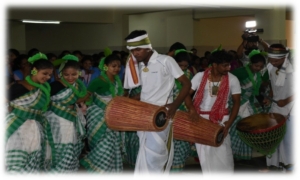 The Mundari is a part of the larger Munda group. The Kol, Kol Lohara, Ho, and Mundari – all belong to the same group as the Kolha, who are considered to be part of the larger Munda group. Mostly Mundari people are found in the Sundergarh, Mayurbhanj, and Keonjhar districts of Odisha. They speak a language called Mundari, which belongs to the Austro-Asiatic language family. Normally, the Mundari identify them as ‘Hodoko’ which means “Human Beings”. They have been living in the same region or place for quite a long time, treating it as their homeland.
The Mundari is a part of the larger Munda group. The Kol, Kol Lohara, Ho, and Mundari – all belong to the same group as the Kolha, who are considered to be part of the larger Munda group. Mostly Mundari people are found in the Sundergarh, Mayurbhanj, and Keonjhar districts of Odisha. They speak a language called Mundari, which belongs to the Austro-Asiatic language family. Normally, the Mundari identify them as ‘Hodoko’ which means “Human Beings”. They have been living in the same region or place for quite a long time, treating it as their homeland.
The dress and ornaments of the Mundari people can be well characterized as very simple and scanty. Their men ordinarily wear a loin cloth. This cloth is from six to nine cubits long and has color borders but on festive occasions, young men also wear a sort of belt around their waist. These are sometimes made of cocoon silk. The dress of the Mundari women normally consists of a long piece of cloth. But due to modernization, the men are wearing pants and shirts and the women are wearing polyester sarees with blouses. Besides these, the Mundari women like to leave their heads and feet usually uncovered. However, while going to the markets or the towns, some well-to-do Mundaris wear ‘pagris’. The pagri is a long piece of cotton cloth that is woven around the head in coils. It serves as a symbol of prestige and provides a protective cover for their head.
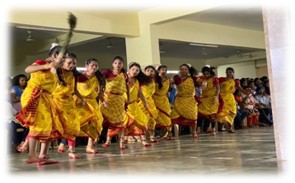 The term Bhumij means one who is born from the soil. Bhumij society is divided into four endogamous groups Tamudia or Tamaria Bhumij, Haldipokhoria Bhumij, Teli Bhumij, and Desi or Dehuri Bhumij. The Desua Bhumij is an acculturated section of the Bhumij Tribe. They are endogamous and do not marry outside their group. They possess many tribal characteristics and live in separate wards maintaining their cultural identity as well as the social distance from other communities. The tribe is divided into several exogamous, totemic, and agnatic descent groups called Killi (clan).
The term Bhumij means one who is born from the soil. Bhumij society is divided into four endogamous groups Tamudia or Tamaria Bhumij, Haldipokhoria Bhumij, Teli Bhumij, and Desi or Dehuri Bhumij. The Desua Bhumij is an acculturated section of the Bhumij Tribe. They are endogamous and do not marry outside their group. They possess many tribal characteristics and live in separate wards maintaining their cultural identity as well as the social distance from other communities. The tribe is divided into several exogamous, totemic, and agnatic descent groups called Killi (clan).
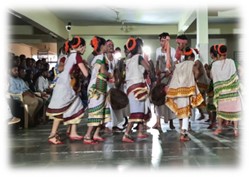 The Kandha is numerically the largest tribe of Odisha distributed in various regions of southern Odisha forming several endogamous territorial sections, namely, Kutia, Dongria, Desia, Sitha, Nanguli, Jhamia, Pengo, Jharia, Malua etc. with the suffix Kandha. Territorial and exogamous clan groups called Kuda or Bons form each section. They organize themselves into territorial clan groups further subdivided into four functional groups called punja, namely, mondal, bismajhi, jani and pujari.
The Kandha is numerically the largest tribe of Odisha distributed in various regions of southern Odisha forming several endogamous territorial sections, namely, Kutia, Dongria, Desia, Sitha, Nanguli, Jhamia, Pengo, Jharia, Malua etc. with the suffix Kandha. Territorial and exogamous clan groups called Kuda or Bons form each section. They organize themselves into territorial clan groups further subdivided into four functional groups called punja, namely, mondal, bismajhi, jani and pujari.
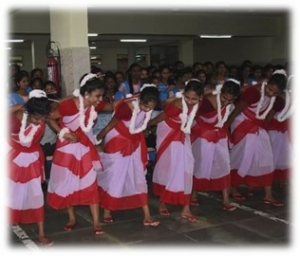 One of the most culturally vibrant tribes ‘Oraon’ constitutes a major tribal community of Odisha. They call themselves ‘Kurukh’ (Kurunkh) which also is the name of their mother tongue. Their cultural life is enriched with their tradition, dance, music, arts, and crafts. The Oraon who once upon a time was more conservative, are now in a transitional stage due to the impact of modernization. The impact of mining and industrialization in their habitat and Christianity which many of them have embraced has changed their traditional way of life to a great extent.
One of the most culturally vibrant tribes ‘Oraon’ constitutes a major tribal community of Odisha. They call themselves ‘Kurukh’ (Kurunkh) which also is the name of their mother tongue. Their cultural life is enriched with their tradition, dance, music, arts, and crafts. The Oraon who once upon a time was more conservative, are now in a transitional stage due to the impact of modernization. The impact of mining and industrialization in their habitat and Christianity which many of them have embraced has changed their traditional way of life to a great extent.
The Oraon trace their origin to some places in Southern India from where they migrated to the Chhotnagpur plateau covering the border districts of Odisha, Bihar, West Bengal, Chhatishgarh, and Madhya Pradesh. In Odisha, mostly they are settled in Sambalpur and Sundargarh districts.
The Oraon generally use their traditional dress. The males use ‘Kareya’ and female use ‘Khanria’ made out of self-made yarn and woven by a weaver Scheduled Caste called Ganda. The Oraon women adorn themselves with varieties of ornaments made of gold, brass, nickel or aluminum. They put on ear ring (sana), coin necklace, beads, glass and metal bangles, finger rings, toe rings and different nose ornaments like dandi, guna, nakachana like the Hindu women. Tattooing is very popular among the Oraon women and they get different parts of their body tattooed. In some villages the boys are also found to have their body tattooed. Except some conservative Oraons, they dress like Hindus and speak Odia language. Their traditional dance and music is their main source of recreation. They have specific dances and songs for different occasions. Young boys and girls of neighboring villages in batches also participate in the dance to celebrate the socio religious ceremonies. The most colorful and popular dance of the Oraon is Karma dance usually performed in Karama Festival observed in the month of September-October.
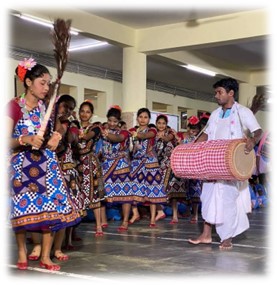 The term ‘Kisan’ has been derived from a Hindi term which means peasant or farmer. They are migrants from Nagpur area and are considered to be an offshoot of the Oraon tribe. They bear different synonyms such as Kuda, Kora, Mirdha, Kola, Morva and Birhor. Kisan is an endogamous community which is divided into a number of exogamous totem. The Kisan profess Hinduism and worship Hindu deities along with their traditional tutelary deities like Gosain, Bhim Devta, Budha Band, Baghia, Samlei, etc. Their traditional community priest Kalo or Soin officiates in the rituals and Brahmin priest worships the deities. The community has its own traditional council known as Jati Samaj headed by a Sardar or Kotwar whose office is hereditary. The other office bearers are Mukhia, the village head and Barika, the regional head.
The term ‘Kisan’ has been derived from a Hindi term which means peasant or farmer. They are migrants from Nagpur area and are considered to be an offshoot of the Oraon tribe. They bear different synonyms such as Kuda, Kora, Mirdha, Kola, Morva and Birhor. Kisan is an endogamous community which is divided into a number of exogamous totem. The Kisan profess Hinduism and worship Hindu deities along with their traditional tutelary deities like Gosain, Bhim Devta, Budha Band, Baghia, Samlei, etc. Their traditional community priest Kalo or Soin officiates in the rituals and Brahmin priest worships the deities. The community has its own traditional council known as Jati Samaj headed by a Sardar or Kotwar whose office is hereditary. The other office bearers are Mukhia, the village head and Barika, the regional head.
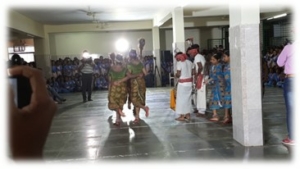 The Bondo Poraja is one of the Particularly Vulnerable Tribal Groups (PVTGs) in Odisha. The tribesmen identify themselves as ‘Remo’ (man). Their neighbours call them ‘Bonda’. Though few in numbers, the tribe has successfully retained the distinctive features of its culture, chiefly due to its geographical isolation, and more perhaps due to its stubborn and independent spirit. The tribesmen exhibit great differences in appearance, customs and character from other tribal groups. Their unique style of personal appearance distinguishes them from rest of the world. Bonda men wear a narrow strip of loin cloth (gosi). It is the women’s attire that is so remarkable. A taboo backed by legends prevents women against clothing themselves above the waist. They make up this very patent deficiency by wearing a mass of brass and bead necklaces and by large heavy circular collars (neck rings) of brass and aluminum. Bondo women weave ringa out of kereng fiber. They are divided into two groups i.e. Upper Bondo or Bara- Jangar group and Lower Bondo. Bondo society is broadly divided into two totemistic moieties or bansha called Ontal (cobra) and Killo (tiger). Ontal is the most numerous and is considered superior to the Killo. The next biggest social unit is the exogamous patrilineal clan organization, which is called kuda and which comprises a number of families who are believed to be descended from a common ancestor.
The Bondo Poraja is one of the Particularly Vulnerable Tribal Groups (PVTGs) in Odisha. The tribesmen identify themselves as ‘Remo’ (man). Their neighbours call them ‘Bonda’. Though few in numbers, the tribe has successfully retained the distinctive features of its culture, chiefly due to its geographical isolation, and more perhaps due to its stubborn and independent spirit. The tribesmen exhibit great differences in appearance, customs and character from other tribal groups. Their unique style of personal appearance distinguishes them from rest of the world. Bonda men wear a narrow strip of loin cloth (gosi). It is the women’s attire that is so remarkable. A taboo backed by legends prevents women against clothing themselves above the waist. They make up this very patent deficiency by wearing a mass of brass and bead necklaces and by large heavy circular collars (neck rings) of brass and aluminum. Bondo women weave ringa out of kereng fiber. They are divided into two groups i.e. Upper Bondo or Bara- Jangar group and Lower Bondo. Bondo society is broadly divided into two totemistic moieties or bansha called Ontal (cobra) and Killo (tiger). Ontal is the most numerous and is considered superior to the Killo. The next biggest social unit is the exogamous patrilineal clan organization, which is called kuda and which comprises a number of families who are believed to be descended from a common ancestor.
 The ‘Gond’ or ‘Gondi’, a scheduled tribe of Odisha, is a tribal peasant community. During the British India, the Gonds had challenged the British rulers in several battle fields sporadically. The history records them as a ‘warrior community’. The Gonds are found spreading over the hill tracts of central and south India. They are one of the numerically dominant tribal groups in India. The name, Gond is derived from the Telugu word Konda meaning the hills. Most of the Gond people speak Gondi dialect, closely related to the Dravidians. A few of them use Indo-Aryan dialect including Hindi and Odia.
The ‘Gond’ or ‘Gondi’, a scheduled tribe of Odisha, is a tribal peasant community. During the British India, the Gonds had challenged the British rulers in several battle fields sporadically. The history records them as a ‘warrior community’. The Gonds are found spreading over the hill tracts of central and south India. They are one of the numerically dominant tribal groups in India. The name, Gond is derived from the Telugu word Konda meaning the hills. Most of the Gond people speak Gondi dialect, closely related to the Dravidians. A few of them use Indo-Aryan dialect including Hindi and Odia.
Gond habitat may be referred to as a habitat for humanity. Their settlement extends mostly over the hill tracts of central India known as ‘Gondwana’ land. Important sub-divisions of the large Gond tribe are Maria Gond of Madhya Pradesh, Raj Gonds and Burve Gond of Maharashtra, Andhra Pradesh and Gonds of Odisha. They are found dwelling near the hills and forest areas of Madhya Pradesh, eastern Maharashtra (Vidarbha), Chhattisgarh, northern Andhra Pradesh, and Odisha. The recent demographic history treats them as immigrants to Odisha. They are concentrated in the state of Odisha in districts like Nabarangpur, Sundargarh, Sambalpur, Bolangir and part of Kalahandi.
The Gonds observe two major festivals, such as Keslapur Jathra and Madai. While the celebration of ‘Keslapur Jathra’ is marked with worshiping the Snake deity – Nagaba, the Madai festival is celebrated to mark the occasion of meeting relatives settled in other part of the country. The Chaitra festival held in month of March is very common for fruit eating ceremony and as well as sowing new crops. During the festivities the Gond women wear colour glass bangles and necklaces made of small black beads and coins and silver. Gusadi – the dance performed by men with costumes decorated with peacock feathers on head along with cotton clothes around their waist and smeared ash body. It is a distinctive feature of Gonds. They enjoy the festivities with sharing drinks and playing and dancing with the rhythm of drum beats and blowing music throughout the night. During dance performance they use musical instruments double humdrums/ drums, harmonium, wooden bells bitten by sticks, etc. Like all the Hindus, the Gonds celebrate the grand festival of Mother Goddess Durga during Dusshera with glee and gaiety. Silver jewellery and decorative turbans form an essential part of the costume of the Gond dancers.
With this, the day-long event ended and was a huge success with the participation of the students and staff members of KISS-DU.

